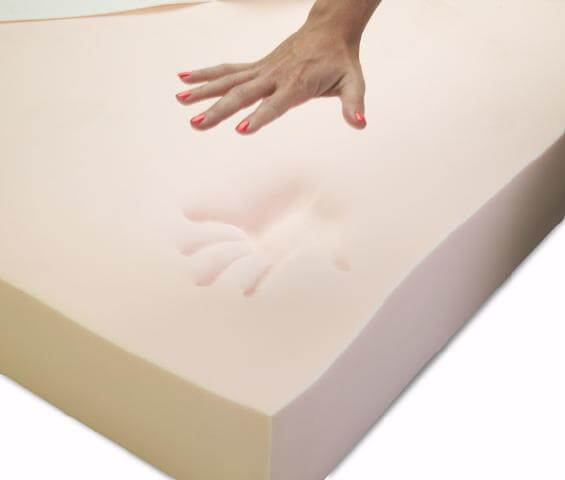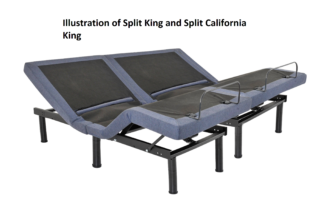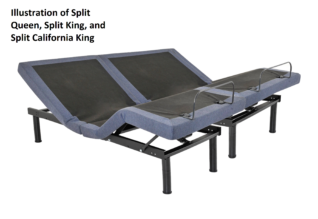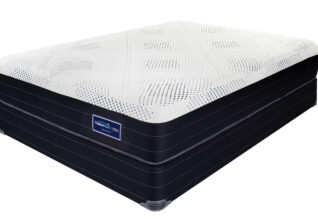Every purchase made online is encrypted with a high level of security you’ve come to expect. Your private information is never shared nor sold, so you can buy with confidence. You can also visit our store if you are in the St. Louis area.

Estimated reading time: 6 minutes
Today we are going to discuss the question “What is the difference between meemory foam and latex?“. Nowadays, mattresses can be crafted from an extensive range of materials, and the type of foams used can significantly impact the cost, performance, and feel of the bed. Among the frequently utilized materials in high-quality mattresses are memory foam and latex foam.
Table of Contents
What Is Memory Foam?
Memory foam, also known as viscoelastic polyurethane foam, is a type of synthetic foam material made from petroleum/polyurethane. It was initially developed by NASA researchers in the 1960s. Memory foam is built with specific chemicals to increase its viscosity and density. Unlike regular polyfoam, memory foam is typically heat-sensitive and reacts to body heat, becoming softer and more conforming when you lay down on it. This results in a “body-hugging” feel as the material adapts to the shape of your body. When you get up, the foam material cools and returns to its original shape.
Related Links
What Is Latex?
Latex is often a natural material obtained from the sap of rubber trees. The sap is processed to create a dense foam material, which has a similar consistency to synthetic materials like polyfoam, but with some notable differences.
Compared to memory foam, latex typically feels more springy and less conforming. It has a rubber-like consistency and is usually dense, making it highly durable. (Think rubber bands, rubber balls, and car tires in terms of their flexibility and ability to return to their original shape. Additionally, latex foams are known for their responsiveness and temperature-neutral properties, which are appreciated by owners of latex mattresses. However, it’s worth noting that latex can be relatively expensive, with high-quality latex mattresses often priced at $1,500 or more, while memory foam beds can be found at a lower price point.

The Difference Between Memory Foam And Latex
When it comes to performance, there are noticeable differences between memory foam and latex. However, it’s important to note that not all latex or memory foam is the same, as factors such as density and material quality can impact the overall feel, firmness, support, and durability of the foam.
- Memory foam provides a plush, contouring feel that conforms to your body when you first lie down and slowly returns to its original shape when you move.
- Latex mattresses, on the other hand, offer a more resilient and responsive feel with a noticeable bounce. While it still adapts to your body shape, it may not contour as closely as memory foam.
- The feel of memory foam is characterized by its deep, body-hugging sensation as it molds to your shape, while latex mattresses are known for their buoyant and responsive feel, with less contouring to your body.
What Do They Feel Like?
Memory foam offers a gentle cradling sensation, while latex mattresses provide a more resilient and bouncy feel, with less pronounced contouring.
How Is The Support?
Both memory foam and latex mattresses are known for their supportive qualities, with the ability to keep the body aligned and enhance overall comfort for the sleeper.
1. Long-Term Support In terms of long-term support, latex tends to outperform memory foam due to its superior durability and responsiveness. While better than most ordinary polyurethane foams, memory foam may sag over time, reducing its supportiveness, latex mattresses typically retain their shape and maintain high levels of support throughout their lifespan.
2. Durability and Support When it comes to durability and support, latex is generally considered to be superior to memory foam. Latex mattresses are known to maintain their shape and provide reliable support for a longer period of time compared to memory foam, which may lose its supportive properties due to sagging over time.
Pressure Relief Comparison
An effective mattress should provide adequate pressure relief to alleviate pain in problem areas such as the hips, neck, and shoulders.
Memory foam excels in this aspect, as it conforms directly to the body’s shape, providing a cushioning effect to common pressure points. When combined with proper support, memory foam allows different parts of the body to sink in as needed without compromising spinal alignment, reducing pain and discomfort for the sleeper. Latex also offers good pressure relief with moderate contouring, but many find that memory foam provides superior pressure relief.

Body Type And Weight Of The Sleeper
The body type and weight of the sleeper can also impact the performance of different mattress types.
In general, memory foam is well-suited for sleepers who weigh less than 230 pounds, as it allows the body to sink in and provides good support. However, for heavier sleepers, memory foam may have too much give, resulting in a less supportive feel. On the other hand, latex tends to perform better for heavier sleepers, as it offers more support and responsiveness.
Temperature Neutrality
Temperature neutrality is another factor to consider when comparing memory foam and latex mattresses.
Memory foam tends to absorb and trap body heat, potentially resulting in a warmer sleeping surface. However, some memory foam mattresses are designed with additional features such as cooling gel, open-cell foam, or other technologies to enhance temperature regulation and mitigate the heat retention issue. These enhancements do not necessarily solve the issues of heat.
On the other hand, latex generally remains more temperature-neutral compared to memory foam. It does not tend to trap heat, making it a better option for those who are sensitive to sleeping hot. However, it’s worth noting that advancements in memory foam technology have led to the development of mattresses with improved temperature regulation features.
Motion Isolation And Disturbance
Motion isolation refers to how well a mattress minimizes motion transfer from one side of the bed to the other, avoiding disturbances for the sleeper. Both memory foam and latex mattresses are known for their good motion isolation properties. Memory foam, with its body-hugging feel, tends to have a slight edge in motion isolation, although latex also performs well in this area. Both materials excel at reducing motion transfer, providing a comfortable sleep experience for couples or light sleepers.
Price Comparisons
The price point of latex mattresses is notably more expensive than that of memory foam mattresses. On average, a latex mattress costs about twice as much as a memory foam mattress. However, it’s important to keep in mind that the long-term durability of latex mattresses can make up for the initial cost difference.
Durability And Warranty
Warranty coverage and durability are areas where latex outperforms memory foam. Typically, latex mattresses have a longer expected lifespan of around 8-10 years of comfort life, compared to 6-7 years for memory foam mattresses. Additionally, latex mattress warranties often provide coverage for a longer duration against body impressions when compared to those for memory foam mattresses.
Contact STL Beds Now
You can also contact us by filling out the form below. Make sure to fill in as many fields as possible so we can respond to you with the most accurate information!



